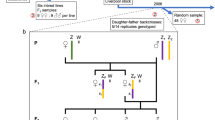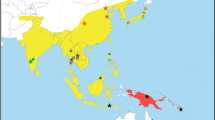Abstract
A field study of the polymorphic African butterfly Danaus chrysippus L. at Dar es Salaam, Tanzania (1972–73) indicated that mating may be non-random between forms dorippus and aegyptius1 and that seasonal sexual selection occurs2. Subsequently, a long-term breeding programme revealed a heterozygous phenotype3 which closely resembles dorippus, and allowed estimates of heterozygote frequency in the field4. Analysis of mating records (1974–75) shows that males visibly heterozygous at the controlling C locus (from transiens)3,4 possessed a highly significant mating advantage over both homozygous phenotypes throughout the study period, although pair composition among the three genotypes was random. I propose here that balancing selection, mediated mainly through male competition for mates, makes a decisive contribution to the control of the polymorphism.
This is a preview of subscription content, access via your institution
Access options
Subscribe to this journal
Receive 51 print issues and online access
$199.00 per year
only $3.90 per issue
Buy this article
- Purchase on Springer Link
- Instant access to full article PDF
Prices may be subject to local taxes which are calculated during checkout
Similar content being viewed by others
References
Smith, D. A. S. Nature 242, 129–130 (1973).
Smith, D. A. S. Science 187, 664–665 (1975).
Smith, D. A. S. Ent. Scand. 6, 134–144 (1975).
Smith, D. A. S. Zool J. Linn. Soc. 69, 87–109 (1980).
Smith, D. A. S. Heredity 34, 363–371 (1975).
Lewis, B. N. J. R. statist. Soc. 125, 88–117 (1962).
Boppré, M. Ent. exp. appl. 24, 64–72 (1978).
Meinwald, J. et al. Experientia 30, 721–722 (1974).
Schneider, D. et al. J. comp. Physiol. 97, 245–256 (1975).
Pierre, J. C. r. Somn. Séanc. Soc. Biogéogr. 486, 179–187 (1980).
Lewontin, R. C. The Genetic Basis of Evolutionary Change (Columbia University Press, New York, 1974).
Owen, D. F. Tropical Butterflies (Clarendon, Oxford, 1971).
Smith, D. A. S. Biol J. Linn. Soc. 8, 183–204 (1976).
Edmunds, M. Heredity 24, 281–302 (1969).
O'Donald, P. Genetic Models of Sexual Selection (Cambridge University Press, 1980).
Author information
Authors and Affiliations
Rights and permissions
About this article
Cite this article
Smith, D. Heterozygous advantage expressed through sexual selection in a polymorphic African butterfly. Nature 289, 174–175 (1981). https://doi.org/10.1038/289174a0
Received:
Accepted:
Issue Date:
DOI: https://doi.org/10.1038/289174a0
This article is cited by
-
Polymorphism and evolution in the butterfly Danaus chrysippus (L.) (Lepidoptera: Danainae)
Heredity (1993)
-
Polymorphism of the tropical butterfly, Danaus chrysippus L., in Africa
Heredity (1984)
-
A general analysis of genetic models with frequency-dependent mating. II. Sexual selection for heterozygotes
Heredity (1981)
Comments
By submitting a comment you agree to abide by our Terms and Community Guidelines. If you find something abusive or that does not comply with our terms or guidelines please flag it as inappropriate.



